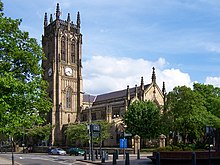Leeds Parish Church
| Leeds Minster | |
|---|---|
| Minster and Parish Church of St Peter-at-Leeds | |

The Minster and Parish Church of Saint Peter-at-Leeds
|
|
| 53°47′42″N 1°32′10″W / 53.79500°N 1.53611°WCoordinates: 53°47′42″N 1°32′10″W / 53.79500°N 1.53611°W | |
| Country |
|
| Denomination | Church of England |
| Churchmanship | Liberal Catholic |
| Website | www |
| History | |
| Dedication | St Peter |
| Specifications | |
| Bells | 12 + flat 6th |
| Tenor bell weight | 40 long cwt 1 qr 27 lb (4,535 lb or 2,057 kg) |
| Administration | |
| Parish | Leeds City |
| Deanery | Allerton |
| Archdeaconry | Archdeaconry of Leeds |
| Episcopal area | Leeds Episcopal Area |
| Diocese | Diocese of Leeds |
| Province | Province of York |
| Clergy | |
| Bishop(s) | Nick Baines |
| Priest in charge | The Revd Canon Sam Corley |
| NSM(s) | The Revd Prof Simon Robinson |
| Laity | |
| Reader(s) | Kay Brown |
| Organist/Director of music | Paul R. Dewhurst |
| Organist(s) | David Houlder |
| Verger | Iain Howell, Noreen Connor |
Leeds Minster, or the Minster and Parish Church of Saint Peter-at-Leeds, (formerly Leeds Parish Church), in Leeds, West Yorkshire is a large Church of England foundation of major architectural and liturgical significance. A church is recorded on the site as early as the 7th century, although the present structure is a Gothic Revival one, dating from the mid-19th century. It is dedicated to Saint Peter and was the Parish Church of Leeds before becoming a Minster in 2012. It has been designated a grade I listed building by English Heritage.
An early 7th-century church on this site was burned down in 633 AD. A church at Ledes is mentioned in the Domesday Book of 1086. The church was rebuilt twice, after a fire in the 14th century, and again in the 19th century. Walter Farquhar Hook, Vicar of Leeds from 1837 until preferment as Dean of Chichester in 1859 was responsible for the construction of the present building, and of the revitalisation of the Anglican church throughout Leeds as a whole. The architect was Robert Dennis Chantrell.
It was originally intended only to remodel the church in order to provide space for a larger congregation. In November 1837 a scheme was approved under which the tower would have been moved from the crossing to the north side, the chancel widened to the same breadth as the nave, and the north aisle roof raised. When work began, however, it was discovered that much of the structure was in a perilous condition, and it was decided to replace the church completely. The new building was the largest new church in England built since Sir Christopher Wren's St Paul's Cathedral erected after the Great Fire of London and consecrated in 1707. The new parish church was rebuilt by voluntary contributions from the townspeople at a cost of over £29,000 and consecrated on 2 September 1841.Florence Nightingale and Dr Edward Bouverie Pusey were among the congregation and Dr Samuel Sebastian Wesley played the organ.
...
Wikipedia
